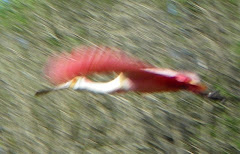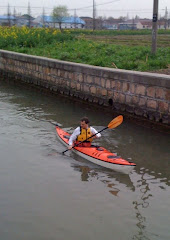Writing books
Always writing; one of my “bucket list” dreams
was to publish a book. It’s the kind of project that requires time, and a
certain amount of persistence.
 |
Some of my titles on my parents' bookshelf |
My first book was a technical kayaking manual for beginners. It presented me with two major challenges. First, how to explain how to perform each maneuver, in as much detail as seemed appropriate, and to arrange everything in logical order throughout the book. Second, how to best demonstrate the essential points of each maneuver, in my kayak, for a photographer to capture in a sequence of photos.
 |
I wrote my first books longhand, ink on paper |
Cut and Paste
My publisher requested each chapter, typed, double-spaced,
as soon as completed, so he could follow my progress. I wrote longhand on
paper, crossing out and writing between the lines until the page became too
overwritten to be usable, at which point I made a clean handwritten copy.
Sometimes I cut out sections and pasted them onto a sheet of paper in a
different order. I used a pen, paper, scissors and glue.
When I was satisfied with what I had written. I typed out each
page carefully, on a typewriter. No typist, I worked slowly using just two fingers,
so the typewriter arms/keys would not jam, and with plenty of white correction
fluid painted over mistakes.
Inevitably I made last-minute changes to almost every page, rendering them too messy to send. That typing stage
took a long time. I duly folded the sheets of each finished chapter into an
envelope, addressed it, attached a postage stamp, and mailed it.
Photographs
After I had submitted the whole manuscript, my publisher
brought a photographer to North Wales. Over the course of three sessions, she shot
all the technical sequences to illustrate the book.
In those pre-digital days, there was no way to view any images until the rolls of film had been sent away to be developed, and contact prints made of each roll. The film was 135, commonly called 35mm. The contact prints, which arrived by mail, were positives of exactly the size of the original negative, each monochrome image just 24 by 36mm, although they would be enlarged for the book.
 |
| 35mm camera film contact print sheet |
With a magnifying glass, I identified all the photographs, cut them out and pasted them onto paper, in the correct order for the chapters of the book. I then labeled the frames we should use from each sequence and added captions. With 13 chapters, the book was lavishly illustrated with 280 photographs, including inspirational action shots.
Canoeing was released in 1990 with an initial print run of 5,000 copies. Sold out and reprinted within 6 months, the book’s success prompted the publisher to ask if I had any other book ideas. Sea Kayaking, Open Canoe Technique and Nigel Foster’s Surf Kayaking followed. It was the book on canoeing technique that finally sparked my first book to be less ambiguously retitled Kayaking.
 |
| My first books were published by Fernhurst Books in UK |
Fernhurst Books collaborated with Globe Pequot Press to increase visibility in the USA, and Globe Pequot opened up new opportunities for me.
Computers
For me, the writing process became easier when I bought a
laptop. It was a Toshiba PC with 4MB RAM and 120MB hard disk, running both DOS
and Windows 3.1 operating systems. It had a version of a mouse, or touchpad, which clipped onto the side of the laptop, with a ball on the top.
The screen was mono. The battery typically lasted for 8
hours of use on one charge. I carried a spare battery and a portable printer when
I traveled.
 |
| My first laptop, mono screen, 120MB hard drive. |
Typing on a computer keyboard was much easier than typing on a typewriter even though at that stage I still found it easier to arrange my thoughts with pen and paper first. The ability to print out the complete requisite physical copy of a book manuscript, double-spaced, for a publisher, was a huge saver of time and effort. But a book, albeit without the color slides or prints, would fit on a single floppy disk which was easier to mail. The publishing industry seemed reluctant to change.
But, although a double-sided high density 3.5-inch floppy disk, with 1.44MB, could store the draft of a book, that would be without images. Color slides and film negatives still had to be physically mailed. Of course, optical storage in CDs and DVDs, with their far greater memory capacity, superseded the magnetic storage on floppy disks, and digital cameras became more available and affordable.
 |
| 3.5 inch floppy disks |
Self-publishing option
My next experiment in authoring came when, failing to find a
publisher, I considered self-publishing the story of my kayaking expeditions to
Baffin Island and Labrador, as Stepping Stones. I found a company, Outskirts Press, which
offered self-publishing for a price, with a menu of options to choose from,
such as cover design, interior layout, indexing, and so on. Each book sold was
printed on demand and shipped by the company, with a royalty paid to the
author.
I was curious to discover whether that was a viable
alternative to using a mainstream publisher. Each appeared to have pluses and
minuses. Mainstream publishers paid in-house editors, and designers for covers
and book layout, and had all the marketing and bookstore distribution set up. Publishers
paid an author an advance of royalties, which reflected their commitment to
getting the book out there to be sold. But each book inevitably took on the
personality of the publisher and its staff to a varying degree, with give and
take. Was that an advantage or disadvantage? I would prefer my books to express
only my own thoughts in my own words.
 |
| Stepping Stones, and later, On Polar Tides |
With a self-publishing service, I would have to pay upfront for any editing,
help with cover design, and interior page layout. I would be responsible for
all my own marketing. I would accrue higher royalty rates, but would that overcome
the extra outgoings? I could buy and sell books myself but would also benefit
from the company’s own distribution. I would run the risk of the book not being
considered credible if self-published.
In my favor, I had several books already published by
mainstream publishers, and I was well known in my field. For different price points,
I calculated how many books I would have to sell to break even, and how many more
I would have to sell to match what I might otherwise expect in advance. It is
impossible to foresee sales figures, but I decided to give self-publishing my
best try. At the least it would be useful research. I considered the results a
success.
I often wonder how Stepping Stones would have sold if originally published by a mainstream publisher. As it happens, it was later released by Falcon Guides as On Polar Tides. With the additions of story elements Falcon recommended, and an insert of color images on glossy high-quality paper, the finished book is better designed and produced than its predecessor. Publishers certainly have skilled and experienced staff. Falcon published my next two books. My best book on kayaking technique so far was one of them: The Art of Kayaking.
Amazon print on demand
At the onset of covid19, I returned from Sumatra, Indonesia, having agreed to write something about kayaking on Lake Toba, the biggest caldera lake in the world. At 60 miles long, Lake Toba sits in the bottom of the crater of a super-volcano in Sumatra. The expedition I had been invited to join, and write about, was supported by National Geographic Indonesia, among others.
Initially envisaging a magazine article, I soon became
engrossed in my research of the Batak people around the lake, with their rich culture and history. Faced with travel restrictions, I took time to dig for hard-to-find information,
and soon had more than enough material for a book.
I had no illusions about my chances of a positive response
from a publisher to a proposal about an expedition on a lake in a remote place
few people have heard of. Besides, at that time, which aspiring writer would
not be taking advantage of a Covid lockdown to send off multiple book proposals?
Acquisition editors must surely have been inundated.
Having completed my draft, I learned, with the help of a retired book publisher friend, how to format a book ready for publication using Microsoft Word. I planned the interior layout, designed a cover, bought my ISBN, and uploaded my files onto Amazon KDP.
 |
| Heart of Toba was the first book I published with Amazon KDP |
Amazon’s print-on-demand service is an interesting way to publish a niche book. There is no upfront charge for anything. If you, as an author, can do all the grunt work, writing, editing, formatting, indexing etc., you can upload just two PDF files and publish without any expense. I ordered proof copies of Heart of Toba, to see exactly how the cover and interior would look, in time to make any adjustments before publishing.
Amazon prints books in various locations around the globe. A book bought in Australia will be printed there. Purchase in Germany and the book will be printed in Germany. This reduces shipping time and cost.
The traditional publishing model would be to print, often in
Asia, a predetermined number of books, based on anticipated sales, and to deliver
to customers via a distribution center in the home country. An international
book distributor would handle overseas orders, but that could affect the
availability, price, and delivery time. With a wide variety of paper types and
book bindings to choose from, offset printing offers more options and can produce higher quality results,
but I have been happy with the print on demand quality of the three titles I
have with Amazon.
With my first Amazon title successfully launched, and and still travel restricted, I next wrote Kayak across France, preparing monochrome images from my digital color photographs to illustrate the story of the journey across France from the Mediterranean to the Atlantic, via the seventeenth century canal du Midi and onward. I would now discover how well print-on-demand tackled images.
 |
| Kayak across France, best appreciated with a glass of wine! |
Iceland by Kayak
I have since published my third book with Amazon KDP: Iceland
by Kayak, about the first circumnavigation of Iceland by kayak. I began preparing the book with the help of the books and charts I
used when planning the trip, and the journals I wrote along the way. My
original color slides and monochrome 35mm film needed cleaning and scanning. When I published, I realized it had taken me 46 years to transform my journal and subsequent research into a book.
Since Amazon now offers hardback in addition to paperback
and digital options, I chose to publish Iceland by Kayak in hardback first, issuing
the paperback later. I am particularly pleased with the quality of the hardback.
 |
| Iceland by Kayak, a fun trip and a fun story! |
Conclusion
Having crafted multiple books over the years, the first with
pen and paper, I have benefited from the advances which technology offers the
writer. Yet the basic process remains the same. We need to find the right story,
the appropriate words to tell it, and a way to present everything in an attractive
and engaging way.
 |
| BUY Iceland by Kayak |









































